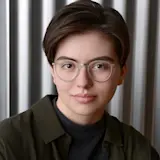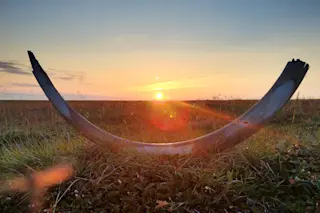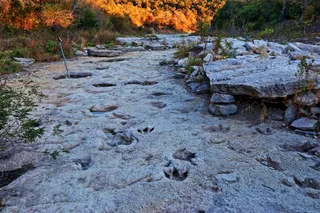The first woolly mammoths were warm, but the last woolly mammoths were warmer. In fact, a paper published in Current Biology states that the most famous features of the woolly mammoths, including their fluffy fur, intensified throughout their 700,000-year stint in Siberia.

Love Dalén, one of the authors of the paper, poses with the Yuka mammoth, whose genome was included in the analyses. (Credit: Ian Watts)
Ian Watts
Woolly, Woolly, Woolier
The token trait of the woolly mammoth, its fur, allowed the species to survive and thrive in the frigid steppes of Siberia for well over 700,000 years. But despite its importance to the species, specialists have always wondered about the trait, struggling to determine when it developed and how it transformed over time.
Attempting to solve these shaggy mysteries, a team of paleontologists and paleogeneticists sequenced the genomes of 23 woolly mammoth specimens and studied their similarities and differences. “We wanted to know what makes a mammoth a woolly mammoth,” says David Díez-del-Molino, a specialist on the team and at the Centre for Palaeogenetics in Stockholm, Sweden, according to a press release.
While other teams have compared one or two woolly mammoth genomes in the past, the team chose to compare an abundance of genomes all at once. This allowed the specialists to identify which mutations were widespread and which mutations were not widespread among Siberia's mammoths, revealing which mutations were adaptive and which were not.
Ultimately, the results revealed that the mammoth’s wool was present since the start of the species, but became more and more prominent over time, making the mammoth better suited to its frosty surroundings.
Read More: Million-Year-Old DNA Yields Mammoth Surprises
The Tangle of Mammoth Traits
The team sequenced the genomes of 23 woolly mammoths, 16 of which had never been sequenced before. They wanted to identify the genes that had been present among the mammoths for a long time and had accrued a lot of mutations throughout that time. While one of the preserved specimen, Chukochya, lived around 700,000 years ago, and is one of the oldest in the world, the other 22 specimens lived around 100,000 years ago or less.
“Having the Chukochya genome allowed us to identify a number of genes that evolved during the lifespan of the woolly mammoth as a species,” says Love Dalén, another specialist on the team and a professor at the Centre for Palaeogenetics, according to the release. “This allows us to study evolution in real time, and we can say these specific mutations are unique to woolly mammoths, and they didn't exist in its ancestors.”
Overall, the 700,000-year-old genome shared almost 92 percent of its mutations with the 100,000-year-old genomes, suggesting that many of the woolly mammoth’s traits were already around when the species split from its ancestor, the steppe mammoth.
That being said, these traits developed throughout the existence of the woolly mammoth. “The very earliest woolly mammoths weren't fully evolved,” Dalén says, according to the release. “Their wool was different — perhaps less insulating and fluffy compared to later woolly mammoths.”
Unsurprisingly, the majority of the genes that were shared among the mammoths were related to the cold conditions of their climates. For instance, the genomes of these specimens showed an advanced ability to metabolize and store fats and to sense temperatures, which only increased over time.
The team also compared the genomes of the mammoths to genomes of more modern species, including those of Asian and African elephants. They found, to their surprise, that several of the mammoth mutations are still found today, not in elephants, but in animals that are adapted to the Arctic.
“We found some highly evolved genes related to fat metabolism and storage that are also found in other Arctic species like reindeer and polar bears, which means there’s probably convergent evolution for these genes in cold-adapted mammals,” Díez-del-Molino says, according to the release.
Of course, the modern mammoths also demonstrated several mutations that were not shared by the old mammoths, including mutations in their immune systems. These mutations may have provided the 100,000-year-old mammoths with an improved immunity against viral pathogens.
Read More: Will Woolly Mammoths Ever Make a Comeback?















